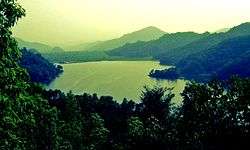Rupa Lake
| Rupa Lake रुपा ताल | |
|---|---|
 View of Rupa lake from nearby hill. | |
| Location | Kaski |
| Coordinates | 28°8′55″N 84°6′40″E / 28.14861°N 84.11111°ECoordinates: 28°8′55″N 84°6′40″E / 28.14861°N 84.11111°E |
| Lake type | Freshwater |
| Primary inflows | Talbesi stream & Dhovan khola |
| Primary outflows | Tal Khola |
| Catchment area | 30 km2 (12 sq mi) |
| Basin countries | Nepal |
| Surface area | 1.35 km2 (0.5 sq mi) |
| Max. depth | 6 m (20 ft) |
| Water volume | 0.00325 km3 (0.00078 cu mi) |
| Surface elevation | 600 m (2,000 ft) |
| Settlements | Lekhnath |
Rupa Lake or Rupa Tal is a freshwater lake in Nepal located in the south-east of Pokhara valley that includes Lekhnath municipality.[1] It is the third biggest lake in Pokhara valley of Nepal and at an altitude of 600 m (1,969 ft) covering area about 1.35 km2 (0.5 sq mi)[2] with an average water depth 3 m and maximum depth 6 m.[3] The lake is elongated north to south and is fed by perennial streams. Its watershed area is 30 km²,[4] where The main inflow of water is from Talbesi stream, whereas Dhovan khola is the feeder stream with its outlet Tal khola at Sistani ghat.[5] It supports a number of floral and faunal species. A total of 36 species of waterbirds have been recorded in the lake which represents about 19 percent of the total 193 wetland-dependent birds found in Nepal.[6]

Lake Economy
Rupa lake is the second main tourism attraction after Begnas Lake outside the Pokhara city. It provides enough space for boating experiences for national and international visitors. Cage culture as well as pen culture have been practiced in Rupa lake for fish farming.[7] Farmers in the Kaski district of Nepal have formed the Rupa Lake Rehabilitation and Fisheries Cooperatives Limited to help protect the watershed.
See also
References
- ↑ "Seven Vanishing Lakes of Lekhnath". Ekantipur.com. 2 April 2010. Retrieved 26 July 2014.
- ↑ Rai, Ash Kumar (2000). "Evaluation of natural food for planktivorous ?sh in Lakes Phewa, Begnas, and Rupa in Pokhara Valley, Nepal" (PDF). Limnology. 1: 81–89. doi:10.1007/s102010070014.
- ↑ Shrestha, Madhav K.; Batajoo, Rabindra K.; Karki, Ganesh B. Karki (2002). FAO Fisheries Technical Paper (PDF). FAO, United Nations. 431. ISSN 0429-9345 ftp://ftp.fao.org/docrep/fao/005/y3994e/y3994e00.pdf. Missing or empty
|title=(help) - ↑ Pradhan, N.; Isabelle Providoli; Bimal Regmi; Gandhiv Kafle. "Valuing Water and its Ecological Services in Rural Landscapes: A Case Study from Nepal" (PDF).
- ↑ Udas, E. "Strengthening Community Based Conservation Approach For Sustainable Management of Rupa Lake Ecosystem" (PDF).
- ↑ kafle, G.; Cotton, M., Bimal Regmi, Jhalak R Chaudhary, Hari Pariyar, Hari Adhikari, Som B Bohora, Umesh k Chaudary, Ashok Ram. "Status of and threats to waterbirds of Rupa lake, Pokhara, Nepal". Cite uses deprecated parameter
|coauthors=(help) - ↑ Shreesthe, M.; Batajoo, R. K.; Karki, G.B. "Strengthening Community Based Conservation Approach For Sustainable Management of Rupa Lake Ecosystem".
External links
| Wikimedia Commons has media related to Rupa Lake. |